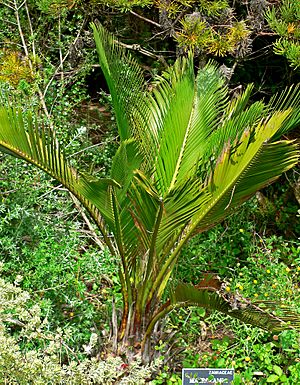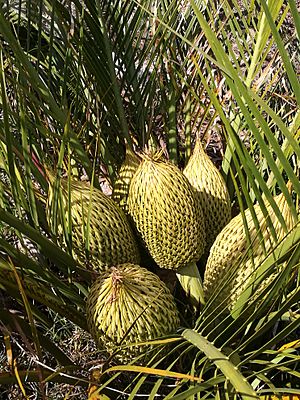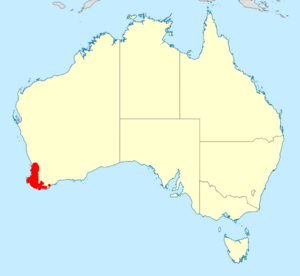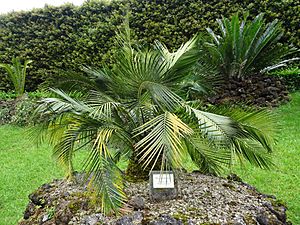Macrozamia riedlei facts for kids
Quick facts for kids Macrozamia riedlei |
|
|---|---|
 |
|
 |
|
| Conservation status | |
| Scientific classification | |
| Genus: |
Macrozamia
|
| Species: |
riedlei
|
 |
|
| approximate distribution map | |
| Synonyms | |
|
Cycas riedlei Fisch. ex Gaudich. |
|
The Macrozamia riedlei, also known as the zamia or zamia palm, is a special type of plant called a cycad. It belongs to the plant family Zamiaceae. This plant is found only in southwest Australia and often grows in jarrah forests.
It can be as short as half a meter or grow a trunk up to two meters tall. Its long, arching leaves are about the same length. The plant produces large cones that hold edible seeds. These seeds are covered in a red, fleshy layer called a sarcotesta. Birds and animals enjoy eating these seeds. People can also eat them, but only if they are prepared in a very specific way.
M. riedlei works closely with tiny helpers: bacteria that help the plant get nitrogen from the air. These bacteria also create substances that can be harmful to some animals if eaten. People sometimes grow this plant in their gardens because it looks beautiful.
Contents
What Does It Look Like?
Macrozamia riedlei is a type of cycad that usually grows without a tall trunk. It can reach a height of about 0.5 to 3 meters.
Each plant has between 12 and 30 shiny, dark green leaves. These leaves can grow to be 1.2 to 2.2 meters long. Each leaf looks like a palm frond, with a thick middle part and 92 to 150 smaller leaflets called pinnae arranged neatly on both sides. The plant usually flowers in September and October.
This type of plant is known for its very large cones. The female cone is especially big, measuring 12 to 25 centimeters wide and 25 to 50 centimeters long. It can even weigh up to 14 kilograms! The cones stay on the plant for many months. The smaller cones that produce pollen stay green, while the larger female cones turn a bright red.
M. riedlei is different from other similar plants in Western Australia. It usually doesn't have a tall trunk, is smaller, has fewer, and shinier leaves, and its cones are smaller.
How It Got Its Name
The first scientific description of this plant was published as Cycas riedlei. It was named by Friedrich Ernst Ludwig von Fischer after a plant sample found at King George Sound. The plant's name honors a French gardener named Anselme Riedlé.
Later, Charles Gardner moved the plant to the Macrozamia group. He used a slightly different spelling, M. reidlei. He studied plants from places like Collie, Manjimup, and Bow Bridge.
Early European settlers called the plant "zamia" or "zamia palm." The local Noongar people have several names for the plant, including baian, djiriji, koondagoor, and quinning. They also have different names for various parts of the plant and its products, as they used it for food and other resources.
Where It Lives
The Macrozamia riedlei plant is found only in southern Western Australia. It grows in soils that contain laterite, often in Jarrah forests.
You can find it along the southwestern coast, stretching east to Dwellingup and Albany. It also grows in the western parts of the Esperance Plains and on the Swan Coastal Plain.
Life Cycle and Ecology
The 'nuts' (seeds) from this plant were an important food source for Indigenous Australians, but only after they were prepared correctly. Early European explorers, however, became very sick when they ate the seeds without knowing how to prepare them.
For example, in 1697, a Dutch explorer named Willem de Vlamingh and his crew got sick after eating the seeds near the Swan River. They experienced severe vomiting. Later, in 1788, the crew of the La Perouse expedition also suffered from similar sickness. In 1801, some of Matthew Flinders' crew also made the same mistake. Even Captain Fremantle, who founded the Swan River Colony in 1829, got sick after trying the seeds.
In 1839, George Grey and his group also became ill after eating unprepared seeds during a difficult journey. They had been shown how to prepare the seeds before, but they didn't do it properly this time.
The by-yu or djiriji plant was very important to the Nyungar people. The fleshy part around the seeds was a staple food once processed. The stem of the plant also provided starch, which early settlers used as 'bush flour' when other flour was not available. The Nyungar people used a special method called mordak to prepare the seeds. An ancient example of this preparation method, found in a cave, is about thirteen thousand years old. The ripe, unprepared seed is called pauyin and can be gathered around March.
Settlers noticed that their cattle would get sick if they ate the leaves of the plant. This sickness, called 'wobbles' or 'rickets', caused paralysis in the cattle's back legs and could lead to death. Because of this, settlers tried to remove the plants from grazing areas.
The plant contains toxins called macrozamin and cycasin. These toxins are made in special roots called `coralloid roots` by tiny helpers called cyanobacteria. These bacteria also help the plant get nitrogen from the air, which is very important for its growth. This process is called nitrogen fixation.
The `coralloid root` system is a partnership between the plant's roots and the cyanobacteria. In M. riedlei, nitrogen capture is most active during wet seasons. Studies show that after a bushfire, the plant produces more of these special roots, helping it to regrow its leaves quickly.
Many animals are attracted to the plant's cones. Insects help to pollinate the female plants. Birds like the Western rosella, emu, common bronzewing pigeon, white-tailed black cockatoo, silvereye, grey butcherbird, and Australian raven eat the fleshy part of the seeds. Mammals like the western grey kangaroo, western brush wallaby, quokka, common brushtail possum, and western quoll also visit the plant.
The Catholic Church in Western Australia sometimes uses the leaves of this plant instead of palm fronds on Palm Sunday. The ancient look of the plant even inspired the poet Judith Wright to write about it.
| Among the complicated birds and flowers They seem a generation carved in stone. — Wright, J. |
Cultivation
Macrozamia riedlei can be grown in gardens as a large potted plant or a special feature plant. It needs soil that drains well and can be sensitive to fungal diseases. Large plants can be moved carefully. Its seeds usually sprout in 12 to 18 months.
Many plants in the Macrozamia group are grown by people, and M. riedlei is one of the more popular ones. It grows well in rock gardens and containers. In gardens, its trunk can reach two meters, and its dark green, palm-like leaves can also grow to two meters or more as the plant gets older. Even though they grow slowly in nature, garden plants can reach a good size. Plants grown in containers tend to be smaller. They respond well to general plant food and prefer full sun or partial shade. They are also a good indoor plant because they can handle low light and cooler temperatures, grow slowly, and can stay in a container for a long time.
The way zamia plants are spread in southwest Australia might be linked to places where people have lived for a long time, especially near lakes, springs, or rocky areas. However, animals like birds and mammals also help spread the seeds. Animals involved in spreading the plant include birds like the emu and mammals like the common brushtail possum (called quumarl by local people). The plant's fruiting cone starts to ripen and break apart during the local season called bunura, which is between February and March, making the seeds ready for harvest.
See also
 In Spanish: Macrozamia riedlei para niños
In Spanish: Macrozamia riedlei para niños



